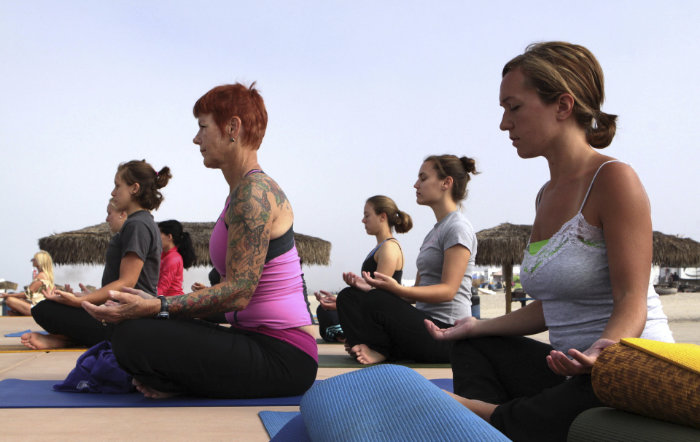
Yoga
Yoga focuses on harmony between mind and body. Yoga derives its philosophy from Indian metaphysical beliefs. The word yoga comes from Sanskrit language and means union or merger. The ultimate aim of this philosophy is to strike a balance between mind and body and attain self-enlightenment. To achieve this, yoga uses movement, breath, posture, relaxation and meditation in order to establish a healthy, lively and balanced approach to life.
❖ Yoga Types
Under this section of Yoga types, different Yoga styles and Yoga paths have been discussed. The prominent Yoga types or Yoga styles are Bhakti Yoga, Hatha Yoga, Jnana Yoga, Karma Yoga, Kundalini Yoga, Mantra Yoga, Purna Yoga and Raja Yoga. Though all the above Yoga styles are popular among the Yoga followers but the Kundalini Yoga type is most sought after in the west. It is interesting to note that different Yoga types have their unique virtues. Some Yoga styles are useful for physical strength whereas some are useful for increasing mental prowess.
1. Bhakti Yoga
2. Hatha Yoga
3. Jnana Yoga
4. Karma Yoga
5. Kundalini Yoga
6. Mantra Yoga
7. Purna Yoga
8. Raj Yoga
❖Limbs of Yoga
Compiled by Maharishi Patanjali in the Yoga Sutras, the Eight Limbs of Yoga are a progressive series of steps or disciplines which purify the body and mind, ultimately leading the Yogi (one who practices Yoga) to enlightenment. While the physical part of yoga is certainly of significance, it is only one of the eight conventional limbs of Yoga practice, all of which have meditation of God as their rationale. These are the eight limbs of the complete yoga system as they are found in the famous Yoga Sutras of Patanjali.
1. Yama - Moral observances for interactions with others
2. Niyama - Moral observances for interactions with yourself
3. Asana - Postures
4. Pranayama - Breathing
5. Pratyahara - Sensory inhibition
6. Dharana - Focus
7. Dhyana - Meditation
8. Samadhi - Blissful absorption of one's individual consciousness in the essence of God.

❖ Yoga Poses
Yoga is all about Yoga poses and postures. There are umpteen numbers of Yoga poses and postures. These Yoga poses or Yoga Asanas have evolved over thousands of years. As Yoga originated in India, most of the Yoga poses were developed by sages and ascetics. There are many important things which need to be kept in mind while trying and executing Yoga postures and positions. At the time of starting Yoga one should very well know his/her body limits. One should listen to his body, especially in the beginning.
1. Adho Mukha
2. Ardha Sarvangasana
3. Asanas at A glance
4. Bhujangasana
5. Dog & Cat
6. Janu Shirshasana
7. Savasana
8. Setubandhasana
9. Sukhashana
10. Tadshana
11. Trikonasana
12. Uttanasana
❖ Yoga Benefits
The benefits of Yoga are numerous. In terms of energy Yoga is like a universe in itself. Some of the important Yoga benefits include anti-ageing, balance and flexibility of body, increase in knowledge and wealth, improvement in mental health and development of personal and social values. This is not the end of story; Yoga also helps in improving strength, sexual life and reducing weight. Yoga makes you feel good. Yoga is relaxing. It's energizing. It's strengthening.
1.Anti Aging
2.Balance
3.Flexibility
4.Personal Values
5.Love
6.Mental Health
7.Social Values
8.Strength
9.Yoga & Beauty
10.Yoga Healing
11.Yoga & Sex
12.Yoga & Knowledge
13.Weight Reduction
❖ Yoga Tips
- The most appropriate time for practicing Yoga is in the morning. It is the time when the mind is calm, composed and fresh and the body movements can be performed with considerable ease and vigor.
- To get started you need to have the urge and confidence in yourself.
- To practice Yoga you must choose a place which is calm, quiet, ventilated, dust free, moisture free and distraction free.
- Before you start Yoga, you must clear your bowels and bladder; clean your nostrils and throat of all mucus. You must also drink a glass of lukewarm water.
- Wait for a few minutes and then you can start.
- Like all other work outs you must begin with easy poses, thereafter you can advance to the tough ones. Be methodical and systematic.
- Remember, to start with your movements should be light and if you feel fatigue in between you must discontinue.
- Yoga must energize and not cause weariness and depression.
- You must take breaks in between if a particular step or exercise proves tiring.
- If you practice Yoga, your diet should be a balanced and you should eat after an interval of 4 hours.
- The quantity of food should be such that it satisfies your appetite.
- Over eating and fasting should be avoided. At the same time you must try to avoid stale food.
- Yoga clothing should be loose and as comfortable as possible. Form-fitting cotton/Lycra pants and shirts are the best.
- While performing Yoga your breathing should be long and deep. You must remember to keep your mouth close and inhale and exhale only through the nose.
- You should always keep a Yoga mat made of some comfortable materials. For lying postures use a woolen carpet, and spread a clean sheet over it.

Meditation
Meditation is one of the five points practiced in Yoga. Meditation relates to positive thinking. Since ancient times sages and saints of India have been practicing Meditation. Meditation is done to reach positive and holistic health. Meditation can be practiced to develop the awareness and the energy required to transform deep-rooted mental habit patterns.
❖ Forms of Meditation
The various forms of meditation comprise of Chakra, Yantra and Mantra. They all aim at calming the mind through concentration. Meditation, the state of extreme absorption leads to peace and empowerment. Meditation is practiced in various styles like concentrating on an image, chanting or regulatory breathing. All of the styles aim at preventing thoughts and aiming at the energy centers in the body.
❖ The Benefits of Meditation
The techniques of meditation are simple and easy to learn, though the ability to keep the mind focused takes time, patience and practice. The practice of meditation, regularly, gives the benefits like reduction of stress, tension, anxiety and frustration, as well as improved memory, concentration, inner peace and physical well being. Meditation have also proved themselves to be highly effective in treating psychological problems such as obsessive-compulsive disorders, depression, schizophrenia, anxiety and irrational fears.
❖ Meditation and Ecosystem
Meditation is an Eco-Friendly way to treat the body, mind and soul. Meditation is a form of treatment, which does not harm our environment and our ecosystem. Our Ecosystem remains intact, as Meditation does not require in biological system to produce treatment.
Tips to Meditate
- Find a quiet place free from distraction
- Sit with your limbs uncrossed and with a straight back, hands in your lap
- Simply breathe at regular speed but breathe deeply and relax
- Close your eyes and think of a beautiful scene from the natural world
- Take a simple phrase and repeat it continuously in time with your breathing

Ayurveda in India
Ayurveda the traditional Indian system of medicine hold out to the world the promise of a healthy long life. When we plan a vacation for India the thought of Ayurvedic therapy strikes our mind.
Ayurveda aims at uprooting the main cause of the disease and its lifetime cure through a proper diet and disciplined lifestyle. Ayurveda, an ancient discipline of medical sciences, evolved in India during Vedic period. The busy and mechanical lifestyles of the people nowadays have increased the popularity of Ayurveda Tours as one of the theme travel tours in India. This in turn has shooted up the graph of tourists coming for the Ayurveda Tours in India.
Ayurveda is based on the principle that the Universe is composed of five basic elements - the Panch Mahabootas, namely: Prithivi(earth), Apya(water), Teja(fire), Vayu(air) and Akash(space). Ayurveda exists on the fact that the Tridoshas - Vata, Pitta and Kapha - in the human body should always be in equilibrium. The unbalanced state of these three elements results in a disease in the body.
We take you on a special Ayurveda Tour in India, which covers the major Ayurveda centres and Ayurveda resorts in India. We offer the Ayurveda Tour with an aim of rejuvenating you mentally as well as physically."Health is not everything, it is the only thing" - this is what the Ayurveda tours in India stress on.
The Ayurveda tours of India offer the purification of the mind, body and soul reviving the individual as a whole. The Ayurveda Tours in India focus on health and rejuvenation goals like de-stressing, detoxification and cleansing, deep relaxation, anti-aging, weight & inch loss.
Many Ayurveda resorts have been set up in India, concentrated mainly in the states of Goa, Kerala, Karnataka and Rajasthan to offer destinations for these Ayurveda tours, the theme travel tour in India.





